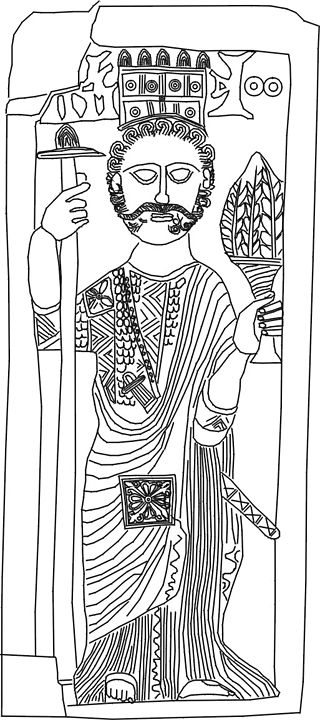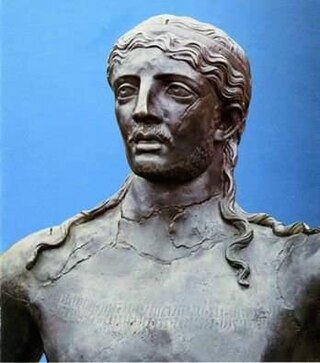Related Research Articles

The Sabaeans or Sabeans were an ancient group from South Arabia. They spoke Sabaic, one of the Old South Arabian languages. In the region of modern-day Yemen, the Sabeans founded the Kingdom of Sheba, which played an important role in the Hebrew Bible, was mentioned in the Quran, and was "the oldest and most important of the South Arabian kingdoms".

Himyar was a polity in the southern highlands of Yemen, as well as the name of the region which it claimed. Until 110 BCE, it was integrated into the Qatabanian kingdom, afterwards being recognized as an independent kingdom. According to classical sources, their capital was the ancient city of Zafar, relatively near the modern-day city of Sana'a. Himyarite power eventually shifted to Sana'a as the population increased in the fifth century. After the establishment of their kingdom, it was ruled by kings from dhū-Raydān tribe. The kingdom was named Raydān.

Abraha was an Aksumite military leader who controlled the Kingdom of Himyar and a large part of present-day Saudi Arabia for over 30 years in the 6th century. Originally a general in the Aksumite army that invaded Yemen around 525 CE, Abraha seized power by deposing the Christian Himyarite king installed by Kaleb. He is famous for the tradition of his attempt to destroy the Kaaba, a revered religious site in Mecca, using an army that included war elephants, an event known as Year of the Elephant.

South Arabia is a historical region that consists of the southern region of the Arabian Peninsula in West Asia, mainly centered in what is now the Republic of Yemen, yet it has also historically included Najran, Jizan, Al-Bahah, and 'Asir, which are presently in Saudi Arabia, and Dhofar of present-day Oman.

Shammar Yahr'ish al-Himyari, full name Shammar Yahr'ish ibn Yasir Yuha'nim al-Manou was a Himyarite king. He was the first to have the title “King of Saba', Dhu Raydan, Hadramawt and Yamnat” and he united most of Yemen during his rule.
Sumyafa' Ashwa al-Yazani, also known as Esimiphaios in Syriac and Greek sources, was a vassal king of Himyar, ruling in the 6th century CE under the Aksumite Empire. He was also the viceroy of the Aksumite king Kaleb, who had invaded Himyar and defeated Dhu Nuwas. Sumyafa' Ashwa was a native convert to Christianity.
Mikhlaf was an administrative division in ancient Yemen and is a geographical term used in Yemen. According to Ya'qubi there were eighty-four makhaleef in Yemen. The leader of a mikhlaf is called a Qil.
Raḥmānān was an epithet and theonym predominantly used to refer to a singular, monotheistic God from the fourth to sixth centuries in South Arabia, beginning when the ruling class of the Himyarite Kingdom converted to Judaism and replacing invocations to polytheistic religions. The term may have also been monolatrous until the arrival of Christianity in the mid-sixth century.
Sharhabil Ya'fur, also known as 'Amr ibn Tubba' al-Himyari, was a Himyarite king who ruled in the 5th century CE. His rule was unique, as he was the only ruler descended from Dhamar Ali Yahbur II who ruled by himself and did not have a co-regent.
Sharhabil Yakkuf also known as Šaraḥbiʾil Yakûf was a king of Himyar who reigned in the 5th century CE. He succeeded the similarly-named Sharhabil Yafur. He is also the founder of a new ruling dynasty, one that is not descended from Dhamar Ali Yahbur II.
Ja 1028 is a Sabaic inscription dating to the late Himyarite Kingdom. It was commissioned by an army commander of Dhu Nuwas named S²rḥʾl Yqbl in which he celebrated massacring the Christian community of Najran and the burning of their church with the army in a move against the Abyssinian Christians of the Kingdom of Aksum based in Ethiopia.

Malkīkarib Yuha’min was a king of the Himyarite Kingdom, succeeding his father Tharan Yuhanim. Byzantine sources and contemporary historians credit him with converting the ruling class of the Himyarite Kingdom from paganism to Judaism. These events are chronicled by the fifth-century Ecclessiastical History of the Anomean Philostorgius and the sixth-century Syriac Book of the Himyarites. Such sources implicate the motive for conversion as a wish on the part of the Himyarite rulers to distance themselves from the Byzantine Empire which had tried to convert them to Christianity.
Thaʾrān Yuhanʿim was a king of the Himyarite Kingdom, and was the second king of the new dynasty founded by his father Dhamar Ali Yuhabirr. He had an unusually long reign, on the order of fifty to fifty-five years and his son, Malkikarib Yuhamin, appears to have entered the throne at an advanced age.
Marthad'ilan Yu'nim also known as Marthad al-Khayr, was a Himyarite king who primarily reigned in the late 5th century CE. He is known for his involvement in the Basus War.
'Abd-Kulāl al-Ḥimyarī, or simply 'Abdkulāl or 'Abd-kalal, was a governor of Himyar who lived in the 5th century CE. He was a convert to Nontrinitarianism, but kept his religious beliefs confidential. 'Abd-Kulal also held the power of regent rule temporarily during his time in office.
Ma'dikarib Ya'fur also romanized as Mu'di Karab Ya'fir, was a Himyarite king who ruled in the 6th century CE. Ma'dikarib Ya'fur was an adherent to Christianity, and served as a vassal ruler over Yemen under the Aksumite Empire. His rule is only attested to in two archaeological inscriptions which date to around 521 CE.

Tha'ran Ya'ub Yuhan'im was a ruler of the ancient Kingdoms of Saba' and Dhu-Raydan, which was located in present-day Yemen. The earliest mention of Tha'ran is in inscriptions from 155 CE as part of a co-regency with his father, Dhamar Ali Yahbur. He succeeded his father around 175 and ruled alone until 214.
Lakhni'ah Yanuf al-Himyari was a Himyarite prince who lived in the late fifth century. He first entered leadership as part of a co-regency with his father, Sharhabil Yakkuf, and his two brothers, Abu Shamir Nawaf and Ma'dikarib Yun'im.
CIH 6, also known as RES 2637C, is a pre-Islamic Arabian inscription from South Arabia. It dates back to the 5th century CE, and commemorates the completion of the construction of a house or palace by the Himyarite regent 'Abd-Kulal and his family. A scanned picture of the inscriptions were first provided by Johannes H. Mordtmann and Eugen Mittwoch in their work Sabäische Inschriften. Rathjens-v. Wissmannsche Südarabischen-Reise. This inscription is also written in the Sabaic language and shows an instance of monotheism in pre-Islamic Arabia.
References
- 1 2 3 Proceedings of the Seminar for Arabian Studies, volume 28, pages 81–88. 1998.
- 1 2 The Oxford handbook of late antiquity. Oxford handbooks. Oxford New York: Oxford University Press. 2012. ISBN 978-0-19-533693-1.
- 1 2 "The values of justice and tolerance in ancient Yemen are conveyed to us by the inscription YM 1200". Al Jazeera Press. 20 January 2017.